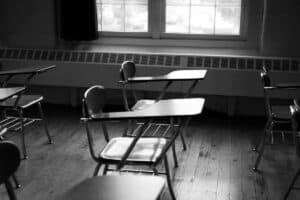It’s a circumstance many in SA face every day, and to claw out of the life that traps her family, is this Boksburg mother's greatest wish.

Just off central Boksburg, on the other side of the railway track, is a building that was once painted bright yellow. It looks as though it could have been a majestic rail-side home once, or an old-time guest house.
Now, just like the plight of its inhabitants, the paint is flaking, the staircase inside is rotting and the single tap in the backyard that provides water for drinking, cooking and hygiene often runs dry.
Boksburg mother and sons call room they rent ‘home’
Ingrid van der Bergh is in her late 30s and along with her two sons, she calls the bedroom they rent for R500 a month, home – along with 27 other families of various permutations.
What most middle-class South Africans take for granted are luxuries to the residents who live here.
The toilet is down the passage, but to flush, anyone with a number one or two must first bucket some water into the cistern from downstairs.
No electricity: Single light bulb and paraffin
There’s no electricity, and Van der Bergh saved up to buy a, small solar panel that charges a light bulb for night time, with dinner prepared on a paraffin stove.
It’s a circumstance many South Africans face every day, and being able to claw out of the life that traps her family, said Van der Bergh, is her greatest wish for both her sons.
But it is been easier wished for than done.
Getting her teenage sons educated has been a battle, with the system and emotionally.
Son bullied ‘just because we are poor’
Van der Bergh’s eldest son is 16, but he has not been to school for months. It’s not that he doesn’t want to learn, but the elitist Afrikaans high school in Boksburg where he was placed turned into a bully’s playground.
“He doesn’t have a phone, his clothes aren’t the best, his uniform was not in a good condition,” said Van der Bergh.
My son was teased and abused, bullied, just because we are poor.
She said the abuse got so bad she became concerned about the psychological impact it may have on her child; and is now looking for an alternative.
Schooling system failing mother and sons
All the while, her younger son graduated from primary school a straight-A student. But there’s simply no space for him in any government school. Van der Bergh has been applying relentlessly for the past six months.
“English schools won’t accept him, because his mother tongue is Afrikaans, and there are just no schools in the area that can accommodate him. And he wants to learn, badly.”
Her 14-year-old said he wants to become a doctor, once he gets to go to school again.
“I want to help my family. I want to help my mother with money. All I want is to do good for them,” he said.
But the system is failing him. Van der Bergh’s boys are not the only kids on the block who have suffered at the tongues of children who enjoy better opportunities.
Some of the building’s children were successfully placed at a school in Reiger Park, a 10km round trip, but Van der Bergh’s niece was placed at the same Afrikaans school as her son.
“I could not take the insults,” said the niece.
“They accused me of deviant behaviour, things that teenagers should not be doing. They teased me because we don’t have money and belittled me all the time.”
Mother an unemployed recovering meth addict
Her mother, Valchinette, is a recovering methamphetamine addict; unemployed, “but clean”. Mom and daughter rely on SA Social Security Agency (Sassa) grants and sharing from their family.
They live in a two-room dorm downstairs from Van der Bergh and her sons. Five days a week, Van der Bergh leaves home at 4.30am, returns at 7pm, and earns minimum wage picking and packing in a warehouse. The Sassa grant covers some of her expenses.
‘It’s tough, but somehow we make it work’
She said her former husband had not paid maintenance for more than five years and nobody knew where he was.
“It’s tough, but somehow we make it work. We have love,” she said. When there is a bit of spare cash, residents band together and have a braai.
Van der Bergh said: “We buy some cheap meat, make a fire and all get together and socialise”.
‘Shadow of poverty’
The children’s playground is the streets that surround the building and an open patch near the railway track.
“It feels like the shadow of poverty follows us everywhere,” said Van der Bergh, “but I will fight tooth and nail to somehow get my kids out of here, and to help them build a better future.”






